Front Page | Home | Blog | Index | Site Map | Contact
![]() Florence
Florence
![]() Lucca
Lucca
![]() Siena
Siena
![]() Pisa
Pisa
![]() San Gimignano
San Gimignano
![]() Prato
Prato
![]() Rome
Rome
![]() Orvieto
Orvieto
![]() Viterbo
Viterbo
![]() Tivoli
Tivoli
![]() Ostia Antica
Ostia Antica
![]() Bologna
Bologna
![]() Assisi
Assisi
![]() Perugia
Perugia
![]() Urbino
Urbino
![]() Ravenna
Ravenna
![]() Parma
Parma
![]() Milan
Milan
![]() Bergamo
Bergamo

2011 Frontpages & Stays
2010 Frontpages & Stays
2009 Frontpages & Stays
2008 Front Pages
2007 Front Pages
2006 Front Pages
- 2006.12.12
- 2006.11.21
- 2006.11.04
- 2006.10.23
- 2006.10.09
- 2006.09.26
- 2006.09.10
- 2006.07.15
- 2006.05.30
- 2006.01.01

Pisa Baptistry and Duomo |
After 41 years Gerry made a return to Pisa . In 1970 He'd made a brief visit there at the end of a conference: he and an Hungarian-Italian drove through the night from near Grenoble to Pisa shared breakfast in the Italian's flat, and said good bye. He had an airplane to catch in Rome but couldn't leave the city without seeing something of its treasures. Jan was not so lucky in her youth!
This time we came together, from Florence. Having months and months to make the trip we put it off for months and months. But finally the pressure of time arrived and so did the good weather. So up we got one morning, went to the Florence train station, and in little more than an hour we were in Pisa.
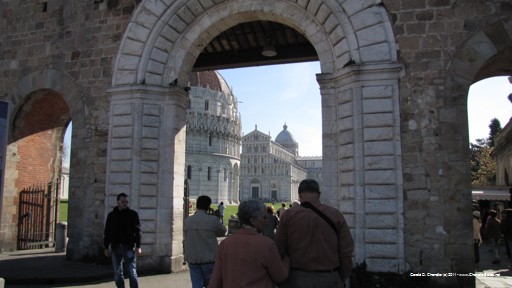
Through Lion's Gate to Monuments |
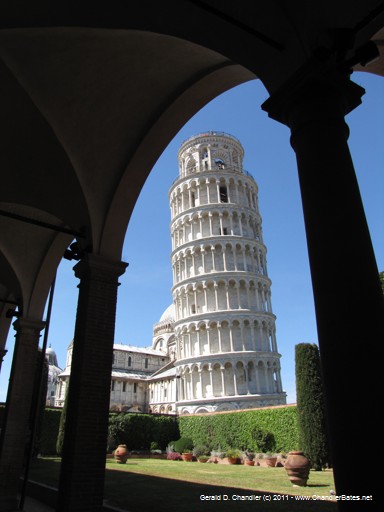
The Tower from the Museum |
We chose an absolutely beautiful day for the trip and got to the station in Pisa with no hiccups. We wanted to take a bus the 1.7km from the station to the Porta del Leone (Lion's Gate) but there we did have hiccups: The bus doesn't leave from the station. By the time we'd walked to the tourist office to get info we were 1/4 of the way there. Then we saw that we were across the street from an interesting looking church, San Antonio, and went in to see. The we had to walk a bit more to get to the bus stop. When it arrived it was jam, jam, packed. So packed that although at the front door and only a meter or so from the driver we couldn't get to him to pay our ticket. So we, propelled by a crowd of other passengers, rolled from the bus into Piazza Manini, and had our few euros to spend on an ice cream later.
We were only a few steps from the gates and went over, stopping to admire the famous perspective. Jan's sister, Sue, had described going through the gate and seeing the three buildings all in a row and how impressive it was, but one is never really prepared for such experiences. Everybody knows that the tower in Pisa leans but how many know about the masterful baptistry and church nearby? How many know that the leaning tower is the bell tower for the cathedral? Thre three black and white marble structures were surrounded by lawns in all their spring splendour and bathed in bright spring sunshine. Truly a remarkable sight.
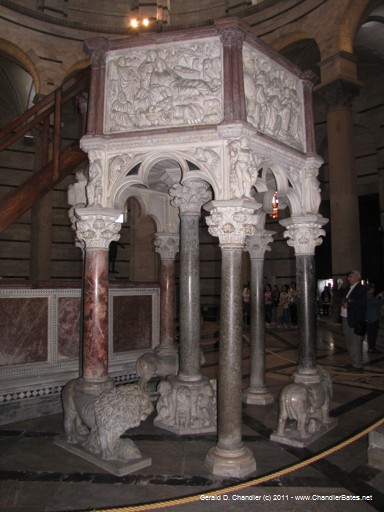
Bapistry Pulpit |
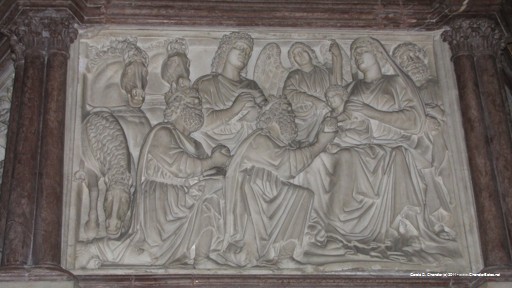
Pulpit bas-relief |
Initially we were at a loss as to where to start. As the old saying goes, start at the beginning. So that is what we did: Since the closest and oldest building was/is the Baptistry we went there first. It's wonderful. (But so are all the other buildings.) First we made a trip arount the outside to admire the stone work and the doors. Then inside to find and admire the huge and very ornate font and of course the wonderful pulpit. We were also treated to a demonstration of the accoustics as the doorkeeper stood near the font and sent her voice echoing up into the dome and back to accompany herself.

Duomo with Baptistry peaking over |
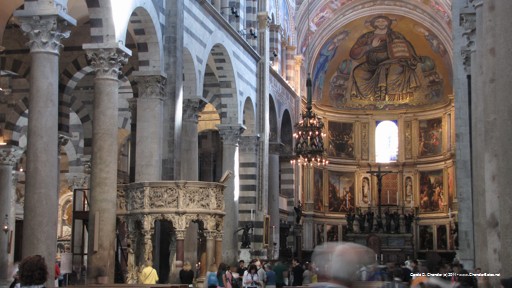
Duomo Nave |

Dumo Ceiling |
Our next stop was the cathedral or Duomo. We were concerned about finding the place mobbed, but in fact although crowded it was quite comfortable and we never felt hassled at all. Another amazing pulpit by Pisano and family, phenomenal marble floors with inlaid images. All very impressive and we wonder how we will keep all of the images that we are being presented with separate in the mind once we leave Florence and Italy. The answer of course is photos. Gerry takes lots and lots of them whenever it is allowed.

Camposanto Monumentale Court |
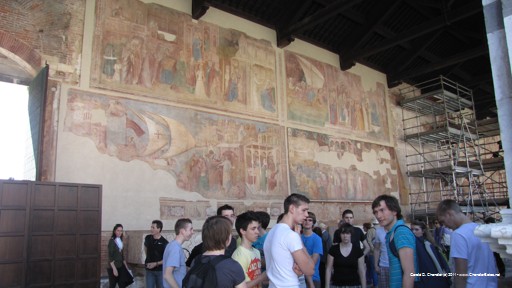
Camposanto Monumentale Frescos |
Although little known, there is a fourth building that makes up the Pisa Field of Miracles. Once a burial place for the great and good of Pisa, it is now a museum of sarcophagi and similar tomb memorials. Called the Camposanto Monumentale (literally monumental cemetery; it's also called the Campo Santo or holy field) it is a quite lovely place consisting of a grassed courtyard surrounded by deep verandahs, known in Italian as loggia, open to the elements on the courtyard side, but with solid walls facing the outside world. Some of the walls contain traces of frescoes, but sadly not much is left. What centuries of neglect didn't do, war did. In the closing days of World War II, as the Germans were being chased from town and Italy, an American bomb hit the Campo Santo. The building burned and most of the frescos were lost. The best remains have been removed and placed in a special exhibit room on one side of the building. The building itself has been restored to what we presume is its former glory.
Now was time to decide on the challenge of the day: climbing the tower. Jan was determined to do it. How could she come to Pisa and not climb the tower? Gerry would have felt the same way but his right leg and knee, being independently minded, vetoed any such effort. All climbs are strictly scheduled and strictly timed. Jan found this out when she went off to get her ticket; fortunately for her there was not a great queue ahead of her: We sat down on a step in the shade to wait; admiring and pitting the youth out on the lawn forming cancer cells.
Shortly it was time and after a brief queueing and some instructions Jan began to climb the 200+ steps. The drill was fixed and could not be varied: As her (or any) group went up they were asked to leave the stairs and admire the view from the outer "terrace". This gave the descending group the chance to pass the ascending group; doing it on the stairs would be impossible. Once at the top people followed nose to back, as if they were pack horses at a dude ranch. Jan did her best to get the view, get pictures, and store memories. She did pretty well. And she even took in the sight of a Russian whose cell phone rang just as her group reached the top. He spent his entire time at the Peak of Pisa bawling out an employee.
While Jan was enjoying the stupendous views of Pisa and its nearby mountains, Gerry went off to the nearby museum of Cathedral works. Inside, in a dozen rooms, were the originals of works that once were in and out of the Duomo and Baptistry. They'd been placed there to preserve them from the elements, vandals, and thieves. Gerry going ahead was a good idea as he's always a slow poke in museums. He'd not gotten through half when Jan was down from the Tower and had caught up to him. Together we finished our our final stop on our tour of the Piazza del Duomo.
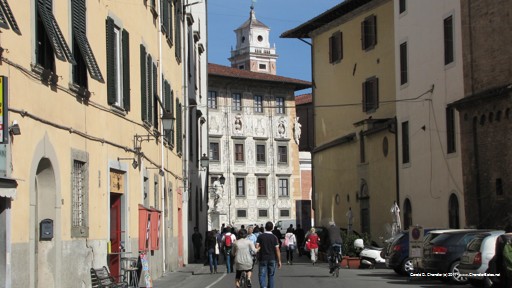
Piazza dei Cavalieri (Knight's Square) from afar |
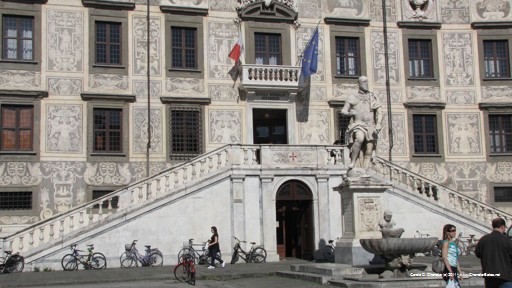
Palazzo della Carovana on Cavaliere |
Now we began to make our way by foot back to the station. We hadn't eaten for a long time and thought a delightful place must be the Piazza dei Cavalieri. We imagined it would be like the Campo in Siena and lined with little cafes. But it wasn't, and we haven't any idea why. But the main sight, the Palazzo della Carovana was well worth the walk
So we walked on an soon came to some covered arcades on the Borgo Stretto. There were several side walk cafes and we chose one. It was okay, except for the cigarett smokers who lit up shortly after we sat down.
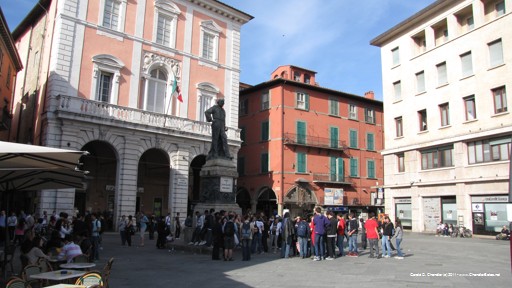
Piazza at Borgo Stretto and the Arno |

Arno Bridge |
We'd hardly stood up when we reached a lively piazza right on the Arno. Here were the cafes that we'd been looking for. But it was too late. So we crossed the Arno and walked along the left bank, going downstream, looking for -- and sometimes admiring -- the sights marked on our tourist map.
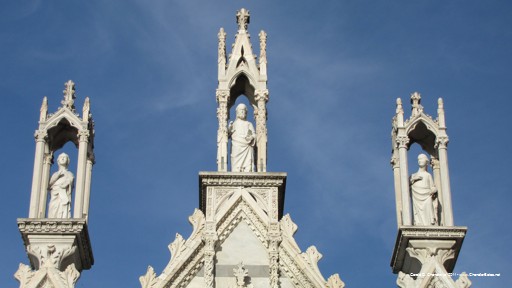
Santa Maria della Spina |
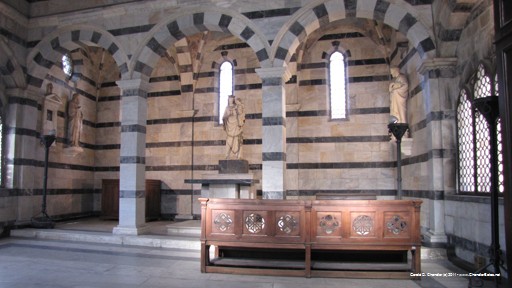
Santa Maria della Spina |
The last thing along the Arno was Santa Maria della Spina, a delightful small church. Then it back to the station via some small streets. Along the way we made a visit to the inside of the Church of San Antonio, which had been closed on our first pass. This time we went the long way around Piazza Vittorio Emanuele II so we could see the king's statue up close. Not that up close, as the square was mostly surrounded by fences that defined some giant construction project. An underground garage? We know not.
Then it was back to Florence. An easy train ride and in time enough not to have to worry about the 23 bus running and taking us home.
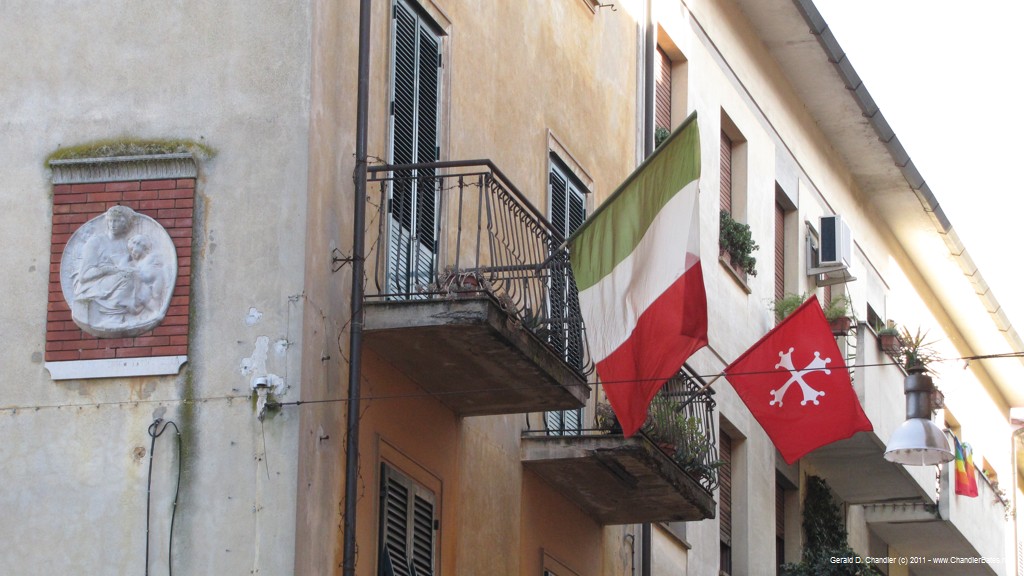
A typical Pisa building |